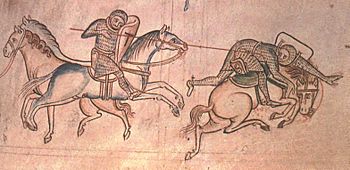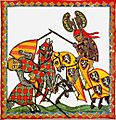Destrier facts for kids

The destrier is the best-known type of Warhorse of the medieval era. It carried knights in battles, tournaments, and jousts. It was described by contemporary sources as the Great Horse, due to its significance.
The word destrier comes from the Vulgar Latin dextarius, meaning "right-sided" (the same root as our modern dexterous and dexterity). This may refer to it being led by the squire at the knight's right side (or led by the right hand) or to the horse's gait, (possibly leading with the right).
While highly prized by knights and men-at-arms, the destrier was not very common. Most knights and mounted men-at-arms rode other war horses, such as coursers and rounceys. These three types of horse were often called chargers.
Characteristics of the destrier
The word destrier does not refer to a breed, but to a type of horse: the finest and strongest warhorse. These horses were usually stallions, bred and raised from colts specifically for the needs of war. The destrier was also considered the most suited to the joust; coursers seem to have been preferred for other forms of warfare. They had powerful hindquarters, able to easily coil and spring to stop, spin, turn or sprint forward. They also had a short back and well-muscled loin, strong bone, and a well-arched neck. From medieval art, the head of the destrier appears to have had a straight or slightly convex profile, strong, wide jaw, and good width between the eyes.
The destrier was specifically for use in battle or tournament; for everyday riding, a knight would use a palfrey, and his baggage would be carried on a sumpter horse (or packhorse), or possibly in wagons.
Images for kids
-
Caparisoned horses competing in a joust from the Codex Manesse
See also
 In Spanish: Destrero para niños
In Spanish: Destrero para niños


